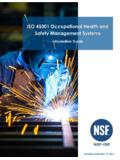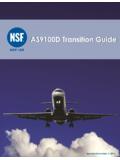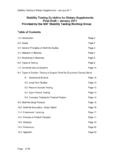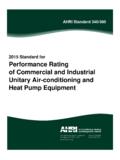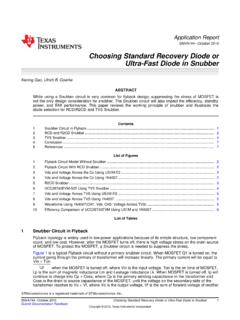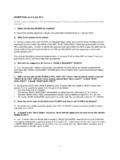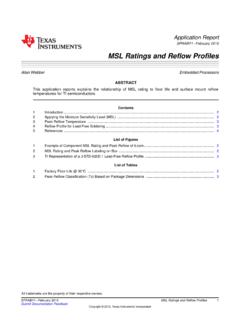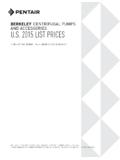Transcription of ISO 14001:2015 - NSF International
1 ISO 14001:2015 Transition Information Commitment & Services Our Values When it comes to our people and the way we work, we possess six core values. We demand the highest ethics and integrity from our professionals. We operate using sound scientific principles. We respect and care for each other. We promote personal and professional growth and foster innovation and creativity. We demonstrate social and environmental responsibility. And finally, we are committed to being the best. NSF Core Values 1. We demand the highest ethics and integrity from our professionals 2. We operate using sound scientific principles. 3. We respect and care for each other.
2 4. We promote personal and professional growth and foster innovation and creativity. 5. We demonstrate social and environmental responsibility. 6. We are committed to winning and being the best. To those ends, NSF International is: ISO 14001 certified Working to meet the criteria of Sustainability Assessment for Professional Services Providers (under development as an ANSI Standard) NSF Services Identify & Reduce Pollution Environmental Management System Certification Landfill Free verification Energy Management System Certification Greenhouse Gas Organizational and project related verification/ validation Protect & Improve Environment Sustainable Forestry Initiative Certification Chemical Management Services - hazard analysis, chemical profiling, toxicology assessments for Supply Chain Management E-waste recycling standard certification Social Operational Health and Safety Management System Certification ISO 14001 .
3 Overview ISO 14001 Environmental Management Systems registration is an internationally recognized standard developed by the International Standards Organization (ISO). This management tool enables an organization of any size or type to identify and control the environmental impact of its activities, products or services, improve its environmental performance continually. Additionally, it provides a systematic approach to setting environmental objectives and targets to achieve these goals and to demonstrate that they met them. ISO 14001:2015 was published on September 15, 2015 and is available for purchase from the NSF Bookstore. Key Improvements to ISO 14001:2015 Utilizing ISO 14001 .
4 2015 as the environmental pillar of sustainability A greater commitment from leadership An increased alignment with strategic direction Greater protection for the environment, with a focus on proactive initiatives More effective internal and external communication, driven through a communications strategy Life-cycle thinking, considering each stage of a product or service, from development to end of life Emphasis on environmental performance and measurement NSF-ISR will be working with each of you (our clients) to ensure a smooth transition over the next 3-years to the new International Standard for Environmental Management System.
5 We are committed to ensuring that your organization understands the updated requirements and what steps your organization may need to take to achieve conformance. ISO 14001 :2004 certificates will not be valid after the 3-year transition period. Organizations looking for first-time ISO 14001 certification are encouraged to certify to ISO 14001:2015 . Existing ISO 14001 :2004 users encouraged to transition early to avoid a bottleneck at the end of the 3-year transition period, or any unforeseen challenges with maintaining certification. NSF International 4 ISO 14001:2015 Has Been ..What Should You Do? NSF-ISR has the tools you need to make a smooth transition to ISO 14001:2015 .
6 Whether you are currently registered and would like to gain efficiency by consolidating your audits, or are looking to newly register, we have to tools and knowledge you need to succeed. All resources are available at Online Readiness Tool Onsite Informational Sessions GAP Analysis Training Sessions Tailored Transition Plans to meet your Needs Transitional Planning Webinars Specialized Sessions Upgrade Planner for ISO 14001:2015 Become Informed Begin to understand ISO 14001:2015 Understand Changes from ISO 14001 :2004 to ISO 14001:2015 Begin Planning The 3-year Transition Period began September 15, 2015 Work with NSF-ISR to help you through transition requirementsCommunicate Team, Top Management, Organization, Interested Parties Questions, needs or suggestions?
7 Contact NSF-ISR NSF International 5 Specialized Training Seminars NSF will be offering upcoming classes for ISO 14001:2015 , beginning in January 2015 . These specialized sessions are meant to give a deeper dive into some of the areas of the Environmental Management System that are new or may need greater explanation. For more information, contact o Lifecycle Perspective o Risk and Opportunities o Establishing Environmental Objectives o Measuring Environmental Performance o Environmental Leadership and Management o Managing Change o Triple Bottom Line Decision Making Major Changes to ISO 14001:2015 Life Cycle Perspective The purpose of Life Cycle thinking is to prioritize actions that can reduce environmental impacts: o Upstream and downstream of supply chain.
8 O Helps identify, evaluate, and interpret significance of environmental aspects o Consider products and unit processes of the organizations o Determine risk associated with threats and opportunities to assure intended environmental outcomes o Risks need to be prevented or reduced o Helps improve transparency, knowledge, control, and management of your supply chain New (or changing) Products & Services need to consider possible environmental impacts (including unintended ones), shifting impacts, sustainability options, alternative approaches, downstream and upstream impacts and final disposal (end-of-life). NSF International 6 Major Changes to ISO 14001:2015 Risk: The Effects of Uncertainty You will want to calculate risk for each environmental aspect of your EMS, which involves: 1.
9 Defining a rating scale for likelihood and consequences 2. Identifying potential risks or threats, likelihood and consequences 3. Documenting assumptions & criteria 4. Identifying activities by risk classification in order of priority 5. Allocating necessary resources to risk management plan 6. Documenting results and develop a Risk Management Action plan (avoid, minimize, mitigate) Your risk management plan should involve updates as compliance obligations and organizational changes take place. It is key to revise and refine your plan with time. Supply Chain Impacts Direct Company Impacts Downstream Impacts Energy Boiler & Manufacturing Emissions Products in Use Raw Materials Fleet Emissions Water Landfill Waste Product Disposal Logistics Recycling Rate NSF International 7 ISO 14001:2015 Certification Transition Timeline o Must identify current organizational gaps o ISO 14001 :2004 will not be valid after the 3-year transition period o Expiration date of certification to ISO 14001 :2004 issued during transition needs to correspond to the end of the 3-year period o Existing ISO 14001 .
10 2004 users encouraged to transition early o Must maintain valid ISO 14001 :2004 Certificate until successfully issued ISO 14001:2015 Certificate NSF International 8 ISO 14001:2015 - Key Emerging Changes & Themes o Strategic Environmental Management Increased role of strategic planning process with focus on actions to mitigate risk and/or exploit opportunities o Risk-Based Thinking Prioritize actions that can reduce environmental impacts o Leadership Leadership to promote environmental management within organization o Protecting the Environment Defines the expectation of the organization to protect the environment Does not define protect the environment , includes proactive actions that include the prevention of pollution, sustainable resource use, etc.



